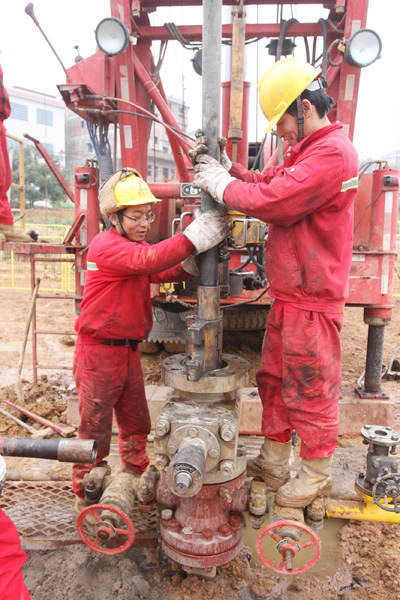|
 |
|
DRILLING: Staff members of Sinopec work on the shale gas exploration well in Qiaotouhe Town, Lianyuan, Hunan Province, on January 7 (CFP) |
Looking to satisfy its growing fuel demands, China is turning to shale gas, natural gas trapped within rock formations.
"China has huge reserves of shale gas. If successful industrialized production is realized, it would significantly ease the nation's energy strain," said Li Shousheng, deputy head of the China Petroleum and Chemical Industry Federation.
China has about 20 percent of the world's total shale gas reserves, the largest in the world, according to a report published by the Ministry of Land and Resources (MLR) on July 23.
The top five countries with the largest minable shale gas reserves are China, the United States, Argentina, Mexico and South Africa.
China's interest in shale gas exploration is increasing with an estimated output of 6.5 billion cubic meters expected by 2015. From 2016 to 2020, the country will enter a fast-growth period in shale gas exploration and development, Liu Tienan, head of the National Energy Administration, said.
Shale gas is formed by gas trapped within shale formations. With methane as its main ingredient, it is a clean and efficient source of energy. The gas is collected through a complicated process called hydraulic fracturing, or fracking. The gas has become an increasingly important source of natural gas and may transform the world's future energy outlook.
The United States introduced fracking technology to the world. Since then, its exploitation technology and optimized pipe network infrastructure have put shale gas exploration on par with collecting other natural resources.
From 2006 to 2010, the output of shale gas in the United States increased 20 fold, from 1 percent of the total output of the country's natural gas in 2006 to 20 percent in 2010. In 2011, the shale gas output in the United States totaled more than 170 billion cubic meters, greatly enhancing the country's stocks of natural gas and reducing its dependence on energy imports.
The shale gas revolution has helped the country become the leading nation in terms of natural gas stocks and also cut its oil imports from 60 percent of total consumption in 2005 to 46 percent. Experts estimate that the United States can change its current reliance on natural gas imports, realize self-sufficiency or even become a leading exporter of natural gas in the next 10 years.
"The exploitation of shale gas has become a highlight of global oil and gas resource extraction," said Zhang Mingsen, deputy chief engineer of Sinopec's Beijing Chemical Research Institute. "This is bound to change the structure of global energy exploration."
China's Sichuan Basin, Ordos Basin, Tarim Basin, the west Hubei and east Chongqing area, and Guizhou and Hunan provinces boast huge stores of shale gas, according to a survey conducted by the MLR.
To tap its reserves, the Chinese Government has unveiled a string of policies to boost production. In March, the government released the 2011-15 plans for the shale gas industry, during which time major shale gas development zones will be established.
According to the plan, the country is set to increase its currently next-to-nothing production to 6.5 billion cubic meters a year by 2015, and then to 60 to 100 billion cubic meters by 2020.
| 